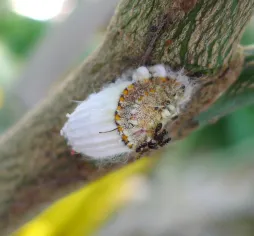Aeonium canariense subsp. vanariense, Canary Island Aeonium
If you want to see an Aeonium Canariense subsp canariense in its natural environment, head for the Canary Islands and Tenerife. This subspecies of Aeonium canariense has taken up residence in the north of the island, in the Anaga mountains.
How to recognize the Aeonium canariense?
Aeonium canariense subsp. Canariense is a succulent plant with a flared habit. It can reach 30 cm in height and 60 cm in diameter.
For the first few years, Aeonium canariense appears aculeate. But then it develops a brown stem. Thin but rigid, it supports the rosette of leaves. The plant rarely branches, as is the case with aeonium canariense. When it does produce shoots, they grow inside the rosette.
The bright green foliage has a velvety appearance. In fact, its spatulate leaves are covered with tiny white hairs.
The inflorescence appears in summer. It's a dense, conical spikeup to 45 centimetres high and 30 centimetres wide. It is covered with yellow flowers.
Aeonium canariense is non-toxic. The plant does not present a risk in the event of skin contact or ingestion.
Our maintenance tips
If you live in a frost-free region, you can plant your Aeonium canariense in the ground, provided the soil remains dry.
Elsewhere, it's best to opt for a pot culture and bring your Aeonium canariense into your conservatory or living room when temperatures drop. The good news is that it's in winter, when the plant is growing, that it reveals all its beauty!
Watering
When it's very hot, your plant needs to be watered accordingly, as it goes into vegetative mode to protect itself.
Aeonium canariense are the enemy of excess water. Before giving your specimen a drink, always make sure the soil is at least five centimetres dry.
Like many plants, the plant prefers rainwater. But it's fine with tap water. Just make sure it's at room temperature.
Remove any water stagnating in the cup under the pot. It can rot the roots.
Do not water during this period.
Spray
Your aeonium canariense hates wet foliage. You must not mist the plant.
Repotting
Re-pot your Aeonium canariense in a pierced pot. Line the bottom with pebbles or clay balls to improve drainage.
Aeonium canariense appreciate well-drained soil. You can use a substrate for cacti and succulents, or mix garden soil with river sand.
Pour a little potting soil into the pot and plant your specimen. Don't hesitate to push in the stem a third of the way up. This way, the plant will be more stable and produce more roots. Fill with potting soil and press down to remove air bubbles.
Prune
To encourage the growth of your Aeonium canariense, prune regularly.
Remove dried leaves.
Cut back flower stems when flowers have wilted. If you use a tool, make sure it's clean and sharp.
Plantation
Choose a sunny, well-drained location, such as the top of a slope or embankment.
Dig a hole two to three times larger than the root ball. Place pebbles at the bottom to improve drainage.
Plant your Aeonium canariense and backfill. If your soil is heavy, mix it with river sand. Tamp down to remove air bubbles.
Cutting
Cutting is carried out during the strong growth phase, generally in spring and early summer.
Remove a shoot. Use a clean, sharp knife if necessary.
Leave the young shoot to dry for 24 to 48 hours, until it has healed.
Leave the young shoot to dry for 24 to 48 hours, until it has healed.
Prepare a perforated pot. Place clay balls or pebbles in the bottom for drainage. Then fill with a light substrate, such as potting soil for cacti and succulents. Use a pencil or pick to make a hole.
Plant your Aeonium canariense. Bury the stem about a third of the way up. This way, your plant will form more roots and be more stable. But don't bury the leaves! Place your cutting in a bright room with a temperature of between 15 and 18°.
Wait a few weeks before watering, to allow the roots to form.
Disease / Threat
Information
| Family | Crassulaceae - Crassulaceae |
| Type | Aeonium - Aeonium |
| Species | Canary Aeonium - Aeonium canariense |
| Lifecycle | Perennial |
| Foliage | Evergreen |
| Exposures | |
| Substrats | |
| Planting methods |
Open ground In pots In tubs |
| Category | |
| Tag |
Fritillary |
| Origin |
Southern Europe |
| Hardiness (USDA) | 10a |
| Leaf color |
|
| Flower color |
|
Discover plants from the same family
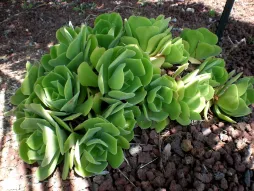
Aeonium canariense virgineum
Discover
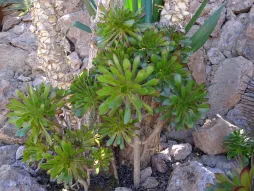
Aeonium arboreum
Discover
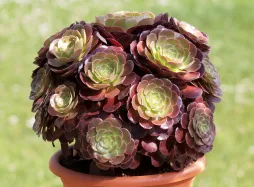
Aeonium atropurpureum
Discover
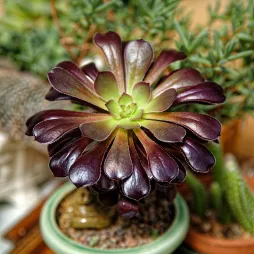
Aeonium 'Zwartkop'
Discover













